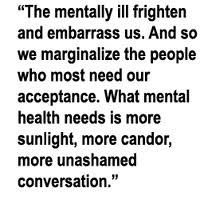 The Stigma Of Mental Illness & The Church
The Stigma Of Mental Illness & The Church
I have come to the realization that the church is often a place for hurting people looking to Jesus for help. They are no different than anyone else other than they are looking to Jesus for the solution to their pain, sickness, troubles, etc. I have also come to the realization that in almost every church there is someone (often many) who are facing some form of mental illness and are also looking to Jesus for solutions.
In my last blog page, I invited comments and suggestion on how the Church can reach out to those facing mental illness. During this blog, I want to look at the issue of stigma.
Oxford English Dictionary (copyright 2012) defined stigma as 1) A mark of disgrace associated with a particular circumstance, quality, or person: “the stigma of mental disorder”; 2) (In Christian tradition) Marks corresponding to those left on Jesus’ body by the Crucifixion, said to have been impressed by divine favor on the bodies of St. Francis of Assisi and others. Synonyms: brand – stain – taint.
1) A mark of disgrace associated with a particular circumstance, quality or person – In Jesus time “leprosy” carried the stigma of a disease of social disgrace to the point that the person with leprosy had to announce their arrival when in public since the disease was so contagious. Not only was it looked upon as a medical disease, but also a social one, for having the disease demanded total social isolation and alienation. One had to move to a leper colony. The epic movie Ben Hur so vividly portrayed this event. The Aids Epidemic was America’s leprosy at the end of the twentieth century, but its stigma has been reduced through progress in medical treatment, education, and social awareness and acceptance. Mental Illness is America’s 21st Century epidemic. The gospels records that Jesus healed the 10 lepers where only one returned to thank him. The 21st Century Church needs to address the topic of healing for those fighting mental illness.
2) Marks corresponding to those left on Jesus’ body by the Crucifixion – IPeter 2:25 reads: “for by his wounds you were healed.” The very stigmatic marks on Jesus’ crucified body should be the very acceptance towards the healing of mental health stigma.
 Often stigma is groomed through ignorance, prejudices, and improper attitudes and judgments. If a person is diagnosed with a brain tumor, the medical world will ask for brain scans, MRI’s, etc. as part of their treatment, all covered by insurance. If a person is diagnosed with a mental illness, they are denied brain scans, given only physical medical clearances before being evaluated by a crisis intervention team, a physician, and possibly a judge to determine if they are in a position “of endangering their lives or the lives of others.” If there is no physical evidence of a possible suicide attempt or a violent action toward a loved one, medical services can and will be denied. That is stigma. Does a patient have to be in their last stage of cancer before being granted help? No, early detection and treatment is encouraged, but not in the mental health field. That is stigma.
Often stigma is groomed through ignorance, prejudices, and improper attitudes and judgments. If a person is diagnosed with a brain tumor, the medical world will ask for brain scans, MRI’s, etc. as part of their treatment, all covered by insurance. If a person is diagnosed with a mental illness, they are denied brain scans, given only physical medical clearances before being evaluated by a crisis intervention team, a physician, and possibly a judge to determine if they are in a position “of endangering their lives or the lives of others.” If there is no physical evidence of a possible suicide attempt or a violent action toward a loved one, medical services can and will be denied. That is stigma. Does a patient have to be in their last stage of cancer before being granted help? No, early detection and treatment is encouraged, but not in the mental health field. That is stigma.
Churches are reeling in trying to learn how to respond to their “high maintenance” parishioners who challenge ethical and moral boundaries when in the depth of depression, the heights of mania, or the whirlwind of a psychotic episode. The Church can offer hope, but hope in what? Churches have told my wife and I that “we are praying for you”, but what are their specific prays? Often socially, those fighting with mental illness find themselves isolated or alienated from the very life that could give them hope, healing, and deliverance, but how is the Church to respond? These are powerful questions being asked of the Church in this century. Is the Church commissioned to speak on behalf of those fighting mental illness? If so how?
 Glen Close Quote:Stigma comes from “not knowing what to do”, and with mental illness everyone involved eventually discovers themselves in that position of “not knowing what to do”, not knowing where to get help, not finding effective support systems to help one through crisis.
Glen Close Quote:Stigma comes from “not knowing what to do”, and with mental illness everyone involved eventually discovers themselves in that position of “not knowing what to do”, not knowing where to get help, not finding effective support systems to help one through crisis.
I have attended a church where many physical handicap people have attended and have been accepted. They have become an integral part of the worship experience that has been healthy for this congregation, but I have also experienced an awkwardness by that same congregation on how to handle mental illness even though there are several people who personally are fighting mental illness in their congregation who are a part of their worship experience. The “not knowing” has been the catalyst to this stigma: the not knowing of what mental illness really is, a physical disease; the not knowing what to do with one in crisis; the not understanding one’s irrational or “insane” actions when the disease is full blown; the awkwardness not knowing how to fellowship with a person struggling with mental illness.  It is not that the church is trying to avoid what to do; it is the “not knowing” what to do, and how to “minister” effectively. In upcoming blogs we will try to unlock the “not knowing”, and begin to try to understand, become empathetic, and eventually feel confident in reaching out to those brothers and sisters in the Lord who are struggling with mental illness.
It is not that the church is trying to avoid what to do; it is the “not knowing” what to do, and how to “minister” effectively. In upcoming blogs we will try to unlock the “not knowing”, and begin to try to understand, become empathetic, and eventually feel confident in reaching out to those brothers and sisters in the Lord who are struggling with mental illness.




































































